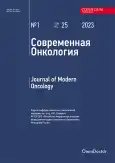Роль минимальной остаточной болезни в терапии острого лимфобластного лейкоза у детей
- Авторы: Коркина Ю.С.1, Валиев Т.Т.1,2
-
Учреждения:
- ФГБОУ ДПО «Российская медицинская академия непрерывного профессионального образования» Минздрава России
- ФГБУ «Национальный медицинский исследовательский центр онкологии им. Н.Н. Блохина» Минздрава России
- Выпуск: Том 25, № 1 (2023)
- Страницы: 73-77
- Раздел: КЛИНИЧЕСКАЯ ОНКОЛОГИЯ
- URL: https://journals.rcsi.science/1815-1434/article/view/132797
- DOI: https://doi.org/10.26442/18151434.2023.1.202154
- ID: 132797
Цитировать
Полный текст
Аннотация
Обоснование. За последние 50 лет произошел значительный прогресс в понимании природы острого лимфобластного лейкоза (ОЛЛ) у детей, разработаны эффективные схемы химиотерапии, появились новые методы диагностики и оценки результатов лечения. Так, определение минимальной остаточной болезни (МОБ) стало важнейшим фактором стратификации пациентов для выбора риск-адаптированного лечения в протоколе ALL IC-BFM 2009.
Цель. Оценить результаты выживаемости детей с ОЛЛ по протоколу ALL IC-BFM 2009.
Материалы и методы. В исследовании оценки эффективности терапии по протоколу ALL IC-BFM 2009 приняли участие 136 человек: 69 мальчиков и 67 девочек (соотношение 1,03:1). Медиана возраста – 4 года и 10 мес. Период наблюдения – с 26.01.2010 по 06.11.2022.
Результаты. Достигнуты высокие показатели благоприятного исхода у детей с впервые диагностированным ОЛЛ: общая выживаемость (ОВ) составляет 91,2%, бессобытийная выживаемость (БСВ) – 82,4%, безрецидивная выживаемость (БРВ) – 88,6%. Наилучшие показатели получены среди больных стандартной группы риска: ОВ, БСВ и БРВ достигают 96,6%. В средней группе риска: ОВ – 96,2% БСВ – 84,8% и БРВ – 88,3%. Хуже результаты выживаемости отмечены в высокой группе риска, где ОВ – 76,9%, БСВ – 65,4% и БРВ – 80,7%. Анализ исхода заболевания в зависимости от иммуноподварианта ОЛЛ выявил статистически незначимую разницу в показателях выживаемости (для В-линейного иммунологического подварианта: ОВ – 92,4%, БСВ – 83,1% и БРВ – 89,5%, для Т-линейного: ОВ – 83,3%, БСВ – 77,8% и БРВ – 83,3%), что определяет тенденцию к улучшению прогноза у детей с Т-ОЛЛ за счет оптимизации стратификации больных, основанной на показателях МОБ, и проведения им оптимальной ветви протокола лечения.
Заключение. Полученные данные о выживаемости пациентов с ОЛЛ подтверждают высокую эффективность лечения по протоколу ALL IC-BFM 2009. Именно уровень МОБ на 15-й день позволяет провести стратификацию пациентов для выбора оптимальной риск-адаптированной терапии.
Полный текст
Открыть статью на сайте журналаОб авторах
Юлия Сергеевна Коркина
ФГБОУ ДПО «Российская медицинская академия непрерывного профессионального образования» Минздрава России
Автор, ответственный за переписку.
Email: juliaskomorokhova@mail.ru
ORCID iD: 0000-0002-8482-1863
аспирант каф. детской онкологии им. акад. Л.А. Дурнова ФГБОУ ДПО РМАНПО
Россия, МоскваТимур Теймуразович Валиев
ФГБОУ ДПО «Российская медицинская академия непрерывного профессионального образования» Минздрава России; ФГБУ «Национальный медицинский исследовательский центр онкологии им. Н.Н. Блохина» Минздрава России
Email: timurvaliev@mail.ru
ORCID iD: 0000-0002-1469-2365
д-р мед. наук, проф. каф. детской онкологии им. акад. Л.А. Дурнова ФГБОУ ДПО РМАНПО, зав. отд-нием детской онкологии и гематологии (химиотерапия гемобластозов) №1 Научно-исследовательского института детской онкологии и гематологии ФГБУ «НМИЦ онкологии им. Н.Н. Блохина»
Россия, Москва; МоскваСписок литературы
- Iacobucci I, Mullighan CG. Genetic Basis of Acute Lymphoblastic Leukemia. J Clin Oncol. 2017;35(9):975-83. doi: 10.1200/JCO.2016.70.7836
- Bhojwani D, Yang JJ, Pui CH. Biology of childhood acute lymphoblastic leukemia. Pediatr Clin North Am. 2015;62(1):47-60. doi: 10.1016/j.pcl.2014.09.004
- Детская онкология. Национальное руководство под ред. М.Д. Алиева, В.Г. Полякова, Г.Л. Менткевича, С.А. Маяковой. М.: Изд. Группа РОНЦ, 2012 [Detskaia onkologiia. Natsionalnoie rukovodstvo pod red. MD Alieva, VG Poliakova, GL Mentkevicha, SA Maiakovoi. Moscow: Izd. Gruppa RONC, 2012 (in Russian)].
- Inaba H, Mullighan CG. Pediatric acute lymphoblastic leukemia. Haematologica. 2020;105(11):2524-39. doi: 10.3324/haematol.2020.247031
- Ольшанская Ю.В., Солдаткина О.И., Никитин Е.Н., и др. Гиподиплоидный кариотип при острых лимфобластных лейкозах из В-линейных предшественников у детей. Вопросы гематологии/онкологии и иммунопатологии в педиатрии. 2021;20(2):97-110 [Olshanskaya YuV, Soldatkina OI, Nikitin EN, et al. A hypodiploid karyotype in childhood B-cell precursor acute lymphoblastic leukemia. Pediatric Hematology/Oncology and Immunopathology. 2021;20(2):97-110 (in Russian)]. doi: 10.24287/1726-1708-2021-20-2-97-110
- Bardelli V, Arniani S, Pierini V, et al. T-Cell Acute Lymphoblastic Leukemia: Biomarkers and Their Clinical Usefulness. Genes (Basel). 2021;12(8):1118. doi: 10.3390/genes12081118
- Raetz EA, Teachey DT. T-cell acute lymphoblastic leukemia. Hematology Am Soc Hematol Educ Program. 2016;2016(1):580-8. doi: 10.1182/asheducation-2016.1.580
- Inaba H, Mullighan CG. Pediatric acute lymphoblastic leukemia. Haematologica. 2020;105(11):2524-39. doi: 10.3324/haematol.2020.247031
- Шервашидзе М.А., Валиев Т.Т. Совершенствование программ терапии острого лимфобластного лейкоза у детей: акцент на минимальную остаточную болезнь. Онкогематология. 2020;15(3):12-26 [Shervashidze MA, Valiev TT. Pediatric acute lymphoblastic leukemia treatment protocols improvement: emphasis on minimal residual disease. Onkogematology. 2020;15(3):12-26 (in Russian)]. doi: 10.17650/1818-8346-2020-15-3-12-26
- Kruse A, Abdel-Azim N, Kim HN, et al. Minimal Residual Disease Detection in Acute Lymphoblastic Leukemia. Int J Mol Sci. 2020;21(3):1054. doi: 10.3390/ijms21031054
- Алескерова Г.А. Лечение детей с острым лимфобластным лейкозом по программе ALL IC-BFM 2002: дис. … канд мед. наук. М., 2018 [Aleskerova GA. Lecheniie detey s ostrym limfoblastnym leykozom po programme ALL IC-BFM 2002: dis. … kand. med. nauk. Мoscow, 2018 (in Russian)].
Дополнительные файлы
















